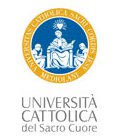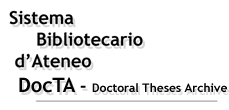|
|
DocTA - Doctoral Theses Archive >
Tesi di dottorato >
SCUOLA DI DOTTORATO IN SISTEMA AGRO-ALIMENTARE >
Citazione:
Utilizza queste indicazioni per citare o creare un link a questo documento.
|
Caffi, Tito. "Epidemology and modelling of grapevine downy mildey primary infections caused by Plasmoparta viticola (Berk et Curt). Berlese et de Toni", Università Cattolica del Sacro Cuore, XXII ciclo, a.a. 2008/09, Piacenza, [http://hdl.handle.net/10280/769].
|
| Titolo: | Epidemiology and modelling of grapevine downy mildey primary infections caused by Plasmopara viticola (Berk et Curt). Berlese et de Toni |
| Autore/i: | CAFFI, TITO |
| Tutor: | ROSSI, VITTORIO |
| Coordinatore: | PIVA, GIANFRANCO |
| Lingua: | ENG |
| Abstract in italiano della tesi: | La peronospora della vite è causata dall’Oomicete eterotallico Plasmopara viticola ed è ampiamente diffusa in tutte le aree caratterizzate da primavere miti e piovose. Gli organi svernanti di questo patogeno sono le oospore, che rappresentano l’unica fonte di inoculo per le infezioni primarie. Recenti studi molecolari hanno evidenziato l’importanza delle infezioni primarie e suggerito una revisione dell’epidemiologia di P. viticola. Questa tesi è costituita dagli studi epidemiologici realizzati per indagare il processo di maturazione e germinazione delle oospore mirati all’elaborazione di un modello dinamico per la simulazione delle infezioni primarie di P. viticola. Il modello è stato successivamente validato in diverse aree viticole italiane e, inoltre, utilizzato come base per un warning system in tempo reale per la gestione dei trattamenti in vigneto. |
| Abstract in inglese: | The heterothallic Oomycete Plasmopara viticola represents the causal agent of downy mildew of grapevine (Vitis spp.). The unique source of inoculum is represented by the overwintering sexual spores, originated by the fusion between anteridium and oogonium, so called oospores. Despite their critical impact on the epidemiology of this disease, knowledge about oospores presents some inconsistencies that are engaged in the present dissertation.
Initially, the effect of water moistening the grape leaf litter holding overwintering P. viticola oospores was investigated. A close relationship was found between vapour pressure deficit (VPD in hPa) and aW (water activity) of the leaf litter, so that when VPD is lower than 2.13 hPa there is sufficient water for oospores to develop. Results showed that moisture of the leaf litter due to the water flow from the atmosphere makes the oospore development possible also during non rainy periods.
Then, the effects of environmental conditions on the variability in germination dynamics of Plasmopara viticola oospores were studied over five years. The germination course was determined indirectly as the relative infection incidence (RII) occurring on grape leaf discs kept in contact with oospores sampled from a vineyard between March and July. The time elapsed between the 1st of January and the infection occurrence was expressed as physiological time, using sums of hourly rates from a temperature-dependent function only in hours when VPD was not a limiting factor (hydro-thermal time, HT). The Gompertz equation calculated over hydro-thermal time produced a consistent modelling of the general relationships between the germination dynamics of a population of P. viticola oospores and weather conditions. It represents the relative density of the seasonal oospores that should have produced sporangia when they have experienced favourable conditions for germination.
Finally, a dynamic model for Plasmopara viticola primary infections on grapevine was elaborated according to a mechanistic approach. Development of the sexual stage of the pathogen was split into different state variables, in which changes from one state to another were regulated by rates depending on environmental conditions. The conceptual model was based on the definition of a primary inoculum season, a seasonal oospore (inoculum) dose, and its division into many coeval cohorts. Each cohort progresses along the primary infection cycle (production and survival of sporangia, release, survival and dispersal of zoospores, infection, appearance of disease symptoms) simultaneously, with a time step of one hour. The model was evaluated by comparing model predictions with disease onset in: i) 100 vineyards of Northern, Southern and Insular Italy (1995 to 2007); ii) 42 groups of potted grapevine plants exposed to inoculum (2006 to 2008). Most of the wrong positive predictions occurred in early season, when the host was in the earlier growth stages, or when the oospore germination was triggered by isolated weak rain events. Considering that neither calibration nor empirical adjustment of model parameters were necessary to obtain accurate simulation, it was concluded that this model produces a reasonable approximation of the primary infection processes underlying oospore development.
A warning system based on such a model and on short-term weather forecasts was developed and its use was evaluated in experimental vineyards over a 3-year period in North Italy. An unsprayed control was compared with a “warning” treatment (fungicides were applied when the warning system predicted an infection), a “threshold” treatment (fungicides were applied as in the warning treatment, but only for the oospore cohorts higher than a fixed threshold), and the grower’s schedule. Average efficacy in decreasing disease incidence on leaves compared to the unsprayed control was > 90% for all treatments. On the average, 6.8 sprays were applied following the grower’s schedule; use of the warning system reduced applications by about one half (warning treatment) or two third (threshold treatment). The grower’s schedule was the most expensive control strategy, with average of 337 €/ha; the average saving was 174 and 224 €/ha for the warning and the threshold treatments, respectively.
The value of this dissertation consists in two relevant and connected aspects. From one side the studies performed on the oospore maturation and germination allowed to better understand and clarify a key point of the downy mildew epidemics still wrapped by a lack of information. From the other side the model elaborated during this thesis represents a practical and efficient tool that leads to the reduction both of growers’ costs and chemical input in the environment. |
| Data di discussione: | 22-apr-2010 |
| URI: | http://hdl.handle.net/10280/769 |
| È visualizzato nelle collezioni: | SCUOLA DI DOTTORATO IN SISTEMA AGRO-ALIMENTARE
FACOLTA' DI AGRARIA
|
File in questo documento:
| File |
Dimensioni | Formato | Accessibilità |
|---|
| 00_tesicompleta.pdf | 1,53 MB | Adobe PDF | non consultabile
|
| 01_frontespizio_indice_abstract.pdf | 18,53 kB | Adobe PDF | Visualizza/apri
|
|
Accesso e utilizzo dei contenuti di DocTA
|



